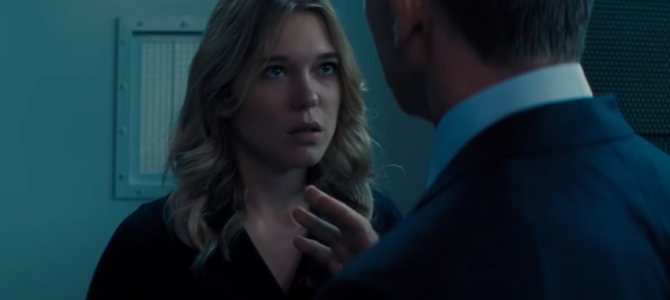
Spoilers.
Who would have thought, as Hollywood fervently tries to dish out one-dimensional girlbosses who nasally remind us every five minutes throughout their movies that they wear pants and can do everything men can do, that one of the most compelling, inspiring female leads to come onto the silver screen lately would be a Bond girl?
But that’s exactly what Léa Seydoux, as the love interest Madeleine Swann to Daniel Craig’s James Bond, brings in “No Time To Die,” released in theaters on Friday.
I remember when my dad took me to see “Spectre” in 2015, in which Seydoux’s character made her debut. We both liked the movie, and I remember him remarking that she was an interesting, refreshing change from the sultry “Bond girl” stereotype. Even as a youngster to whom the Sean Connery and Roger Moore eras were historical, I could tell the difference he was noting.
Madeleine Swann wore light makeup, and her iconic evening gown was a throwback to old Hollywood glamour that was sexy precisely because of what it left to the imagination.
“I think I’m not really the stereotyped Bond girl,” Seydoux said at the time. “She’s not a fighter, she’s a doctor. She fights in another way.”
Here was an opportunity, as Hollywood backed away from the classic Bond girl and as Victoria’s Secret retired its Angels, for the 007 industry to turn its female protagonist into a woke girlboss who could take care of herself and didn’t need the outdated masculinity that James Bond had to offer. They even teased such a progression, with Swann delivering an “I can look after myself” line to Bond in “Spectre.”
It’s also worth noting that in the lead-up to Craig’s final Bond movie, many commentators fluttered about replacing him with a female Bond. “No Time To Die” does have a new, female 007, played by Lashana Lynch.
Unfortunately, the movie takes no time to develop this new 007 into a compelling character, instead feeding her stale one-liners that tell us nothing about her except that she is desperate to prove herself a better Bond than Bond. It will be telling to see how she takes shape in the future, but “No Time To Die” spent far more of its time on Swann, presumably leaving Lynch’s character for a possible future series of her own. And in Swann’s case at least, “No Time To Die” took an unexpectedly refreshing direction.
Strength Through Femininity
Instead of stripping Swann of her femininity and putting her in an awkward power competition with Bond, the movie leaned into her womanhood. Seydoux’s comment that Swann “fights in another way” is a candid recognition that Swann isn’t trying to be A Man But Better.
She doesn’t shoot up the villains in over-the-top action sequences. She doesn’t have to. Rather, she’s tapping into the complementary strengths she has as a woman, and the result is just as captivating as any powerfully feminine woman is.
“We have access to her vulnerability and that is something new,” Seydoux noted in an interview about the film. But it doesn’t make Swann any less tough, capable, or admirable. On the contrary, it gives a compelling depth to her strength.
One of Seydoux’s directors described her as having “some graceful emotional thing unique to her.” It’s almost like the word he’s looking for is femininity.
After subtly leaning into Swann’s strength-through-femininity, “No Time To Die” jumps in headlong by revealing Swann to be a mother. When Bond reconnects with her after five years apart, he finds her living a quiet life with her young daughter.
Motherhood doesn’t dilute Swann’s toughness or dignity, but increases it. The film showcases her motherly tenderness and fierce protectiveness of her daughter — actually making them a key part of the plot — in a way that seems very natural and empowering.
A Complement To Masculine Valor
When Bond enters the picture, even before we learn that the child is his, Swann welcomes his help and looks to him for protection as any mother would, with no “I can do it myself” chip on her shoulder. She’s clearly courageous and willing to fight to her last breath to protect her child — she’s no helpless, fainting maiden — but she doesn’t have to be the one drop-kicking the bad guys.
And the movie’s climax, when Bond sends Swann and their daughter to safety while he remains to call in a missile strike on himself to destroy an island-turned-bioweapon-factory, is a powerful moment. The invincible Bond, who once attracted and subsequently dropped glamorous women at every turn, genuinely loves Swann and finds his characteristic nonchalance disarmed by it.
As soon as he realizes it, though, he’s forced to give his life up to save them. It’s a tragic scene, and a romance in the real sense of the word. Bond’s final moments, telling his daughter and her mother goodbye while standing atop the island waiting for hellfire to rain down, have the same pathos as accounts of the men of the Titanic sacrificing for their wives and children.
It’s a compelling picture of masculine valor, the likes of which I can’t remember last seeing in theaters (at least, outside of war movies). Far from detracting from Swann’s feminine strength, Bond’s protection complements it. From perhaps the most unlikely of franchises, we get a stirring picture of what looks a lot like the sacrificial love of a husband for his wife and of parents for their children.
It’s not exactly what you’d expect from Bond, so think what you will about such a change of tone. But “No Time To Die” certainly doesn’t make Bond any less manly, or his girl any less a feminine beauty. If anything, they seem like older, wiser versions of their former selves — arguably fitting for the last movie in the Craig saga.









